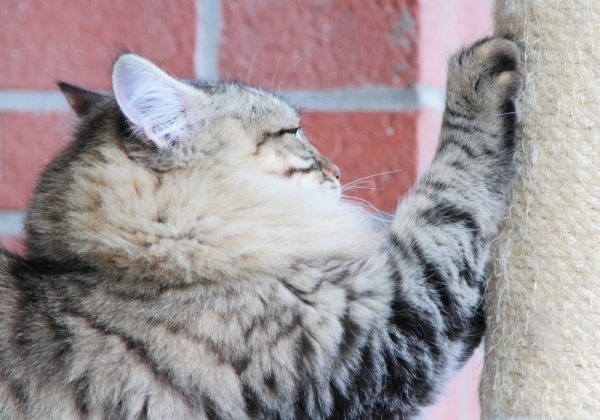Knowing what causes your cat to scratch your furniture (and everything else) is the key to preventing it.
ats clawing on furniture and furnishings is a natural behaviour; they don’t do it simply to irritate their owners (although it's easy to think they take some form of sadistic glee when they see the look on our faces as our new upholstery is in shreds). They are performing basic body maintenance, both in keeping their claws in good shape as well as by stretching their legs, shoulders and paws. They are also literally marking their territory and communicating boundaries to other pets in the home. Since this is a natural activity for cats, it does take some effort and ingenuity to channel these impulses into something less destructive, but it most certainly can be done.
They are performing basic body maintenance, both in keeping their claws in good shape as well as by stretching their legs, shoulders and paws.
Having at least one scratching post for your cat is the absolute minimum, and it is best to have several placed throughout the house. A scratching post is the easiest and cheapest answer to a scratching problem, but it will take time and a bit of patience on both parts to encourage your cat to use it.
When buying a scratching post, there are a few things to keep in mind. Look for one that is at least as tall as your cat when they stand on their hind legs (the point is to give them somewhere to get a really good body-length stretch). Make sure it’s pretty sturdy and isn’t too heavy or tall, though, or it may fall on your cat.
Next, work out which pieces of furniture the cat has clawed, which should be pretty obvious, and leave a scratching post in the room next to any furniture the cat seems to prefer scratching.
Your cat might always be scratching at the chair or sofa that you regularly sit in, displaying ownership and affection behaviours. Try leaving a piece of your clothing on the top of the scratching post for a while, so that your cat sees it as part of your territorial marker, just like the sofa or armchair.

'You just gotta scratch that itch, scratch that itch'
Train your cat to use a scratching post
Encourage your cat to unfurl her claws on the new scratching post by placing her in front of it. At the same time, stroke her and wait for her to respond to the post.
Show your cat what to do by placing her front paws onto the post and gently mimic the movement you’d like her to make (of course, be careful if she has a bad temper as she might not take kindly to this). You can also dangle a toy over the scratching post so that it bangs against the post. This will likely get your cat’s attention and entice her to interact with it.
If your cat isn’t paying much attention to the post, try putting it in different places. It may be that it takes a while for your cat to discover it and start using it in earnest; if you don’t force it, she will discover it in her own time. Every time she uses the scratching post, offer her praise, give her a stroke and perhaps a treat.








